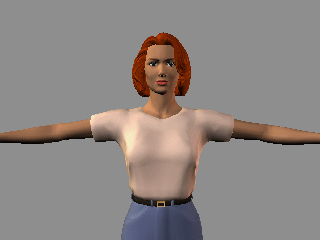Spins and Turns
Spotting
Spotting is the process of delaying the rotation of the head, relative to the body's rotational speed, by way of visual focus on one or more fixed points in space.

Spotting serves several purposes. The following is a list of the most common benefits of spotting during turns:
- Keeps dancer oriented and aware of the movement, direction, and location of the body in space.
- Prevents disorientation caused by lack of visual focus.
- Increases the overall speed of the rotation.
- Makes the spin appear much faster and sharper than it actually is.
- Reduces dizziness associated with spinning.
When you spot, the goal is to keep the head fixed in space while the body turns underneath. This is best accomplished by maintaining visual focus on a particular object in the room.
Generally, the range of motion of the neck allows the head to turn slightly less than 180, from one shoulder to the other. When the body has turned to the point that the neck has reached its maximum range of motion (with the head looking almost over one shoulder), the head will quickly turn around to the opposite side (the other shoulder) to focus on the same spot. The action of quickly switching the head is known as refocusing the spot, and should be done in a very swift motion in only an instant.
Because the range of motion of the neck is slightly less than 180 the spot can only be held (i.e. focused upon) for slightly less than 180 of the entire turn. The other *slightly more than* 180 of the turn occur with the head not focused on the spot, as it switches from one shoulder to the other.

Foucused and Unfoucsed Half of the Turn
When the body is turned to a direction within the light gray area, the dancer can maintain focus on the spot. When the body is turned to a direction within the darker gray area, the focus cannot be maintained on the spot, and the head will turn from one shoulder to the other.
Notice in the animated picture at the top of the page that the head is looking forward for approximately one-half of the turn, but for the other half, it appears to be looking away. Actually, it's turning from one shoulder to the other, or "re-focusing the spot".
If you watch the animation closely, you'll notice that the action of re-focusing the spot appears to be very slow. The reason for this is that the body is turning at a constant speed. In order to re-focus the spot with a swift motion, the body would need to turn much faster during the unfocused half of the turn than during the focused half. This is the challenge in learning to spot.
Important facts about spotting:
- Spotting is a common technique used for spins, but it is not the only one. Other techniques used in modern ballroom dancing include maintaining a strong shape to the left or right, or even looking straight up at the ceiling!
- Spotting can help reduce dizziness to a limited degree, but the best way to overcome problems with dizziness is through experience, by simply getting the body accustomed to spinning.


